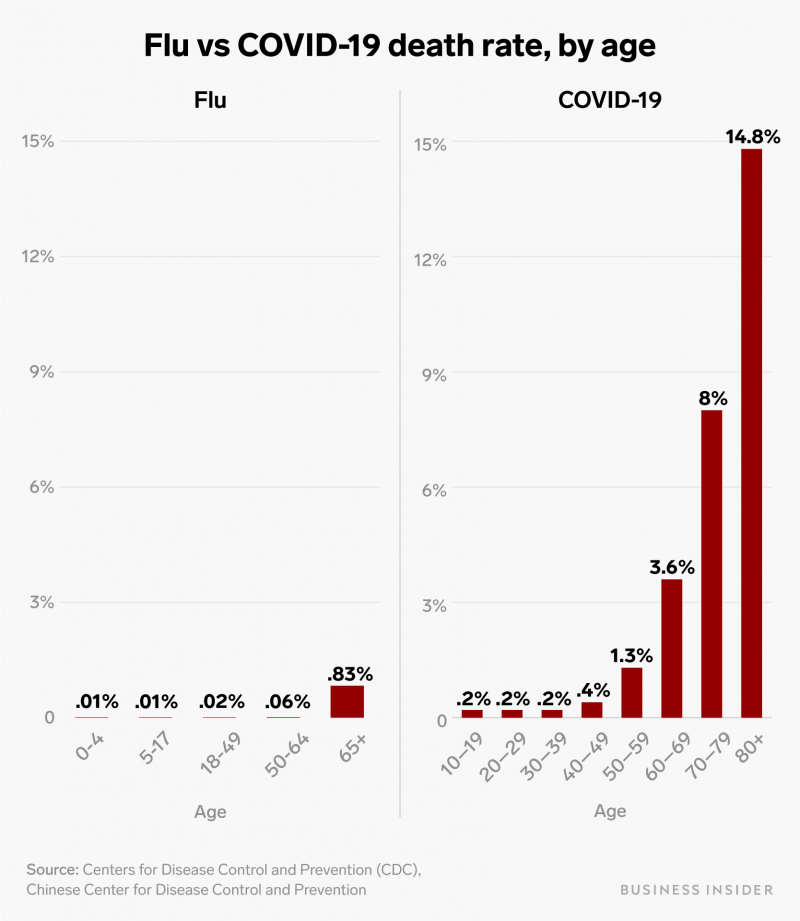- The flu and the new coronavirus have similar symptoms, but the coronavirus has been far deadlier.
- Here’s how the death rates compare.
- For the latest case total and death toll, see Business Insider’s live updates here.
- Visit Business Insider’s homepage for more stories.
The coronavirus outbreak came in the middle of flu season in the Northern Hemisphere.
Many people have highlighted the overlapping symptoms of the flu and COVID-19, the disease caused by the coronavirus. Even President Donald Trump asked pharmaceutical execs if the flu vaccine could be used to stop the coronavirus.
But Tedros Adhanom Ghebreyesus, the director-general of the World Health Organization, warned against taking such comparisons too far.
“This virus is not SARS, it’s not MERS, and it’s not influenza,” Ghebreyesus said in a press conference on Tuesday. “It is a unique virus with unique characteristics.”
The most crucial difference between the flu and the coronavirus is that the latter has been far deadlier. Whereas about 0.1% of people who get the flu die, the coronavirus' death rate is now at about 3.4%, based on the current numbers of cases and deaths.
How the death rates of the flu and the coronavirus compare
The novel coronavirus that originated in Wuhan, China, in December has killed over 3,200 people and infected nearly 94,000 people, mostly in China. It has spread to at least 80 other countries. The US has confirmed more than 125 cases and at least nine deaths.
Older people are far likelier to die from the coronavirus than younger people, and the same is true for the flu - though not to the same extent.
Here's how the death rates of the two compare in different age brackets:

The flu kills thousands of people every year, but its death rate is low
During the 2018-19 flu season, about 35 million people in the US contracted the flu and about 34,000 died, according to the Centers for Disease Control and Prevention. This flu season, an estimated 32 million people have gotten the flu, with 310,000 hospitalizations and 18,000 deaths.
The agency estimates the number of flu infections in the US via its influenza surveillance system, which gathers flu data from state and local partners, then projects nationwide totals using infectious-disease models.
During the 2018-19 season, about one out of every 1,000 people who got the flu died.
However, breaking down the numbers by age range reveals a more complex story. Among children, there was about one death in every 10,000 cases. In adults between 50 and 64, about six out of every 10,000 people who got the flu died. For people 65 and older, the rate rose to about 83 out of 1,000.
While the flu's death rate is low, it varies depending on the strains circulating each year. The flu virus also mutates rapidly, so people can get infected by different strains, which is why the shot isn't 100% effective and why new vaccines are developed every year.
About 15% of coronavirus patients over age 80 have died
The coronavirus is more fatal than the flu across all age ranges, but especially among older people, according to research from the Chinese Center for Disease Control and Prevention published in mid-February. It also more seriously affects people who already have health problems.
Among people 10 through 40 who got the coronavirus, about four out of every 1,000 died, according to the Chinese CDC's figures. But 8% of people between 70 and 79 died, and the rate rises to about 15% among those 80 and over.
Here's how the coronavirus compares to a handful of other major outbreaks:
Research suggests that about 80% of coronavirus cases are mild.
One reason the coronavirus is deadlier than the flu: It's still new
Ghebreyesus said one reason the coronavirus' death rate is so much higher than the flu's is that this is the first time humans are encountering it.
"While many people globally have built up immunity to seasonal flu strains, COVID-19 is a new virus to which no one has immunity," he said in the briefing. "That means more people are susceptible to infection, and some will suffer severe disease."
We have vaccines and therapeutics to help prevent and treat the seasonal flu, but there are no known cures for the coronavirus. However, scientists are racing to develop treatments and vaccines to stop the outbreak: The biotech company Gilead is testing a drug called remdesivir, and Moderna has submitted a potential vaccine for initial testing.
Stopping the flu and the coronavirus from spreading
The flu and the coronavirus spread in the same way: via viral particles that travel between people in tiny droplets or saliva and mucus. If a sick person sneezes, coughs, or eats within 3 to 5 feet of someone healthy, the particles could land on the healthy person; if the particles enter the person's eyes, nose, or mouth, the person can become infected.
The flu is extremely efficient in passing among people before an infected person shows symptoms. But the coronavirus doesn't operate in quite the same way.
"COVID-19 does not transmit as efficiently as influenza, from the data we have so far," Ghebreyesus said.
That means containment is still possible, he added.
"We don't even talk about containment for seasonal flu - it's just not possible. But it is possible for COVID-19," Ghebreyesus said. "We don't do contact tracing for seasonal flu, but countries should do it for COVID-19, because it will prevent infections and save lives."
- Read more:
- A mall in Texas closed due to coronavirus concerns, and it reveals how shopping centers could be jolted by a wider outbreak
- Public health legend Anthony Fauci says working with the White House during an outbreak can be difficult because politicians can cause complacency in their attempts to 'calm people down'
- The US has reported 9 coronavirus deaths among more than 120 cases. Here's what we know about the US patients.
- Walmart, McDonald's, Home Depot, and 8 other retailers share how the coronavirus outbreak could affect business
